engine PONTIAC VIBE 2010 Manual PDF
[x] Cancel search | Manufacturer: PONTIAC, Model Year: 2010, Model line: VIBE, Model: PONTIAC VIBE 2010Pages: 318, PDF Size: 1.7 MB
Page 204 of 318
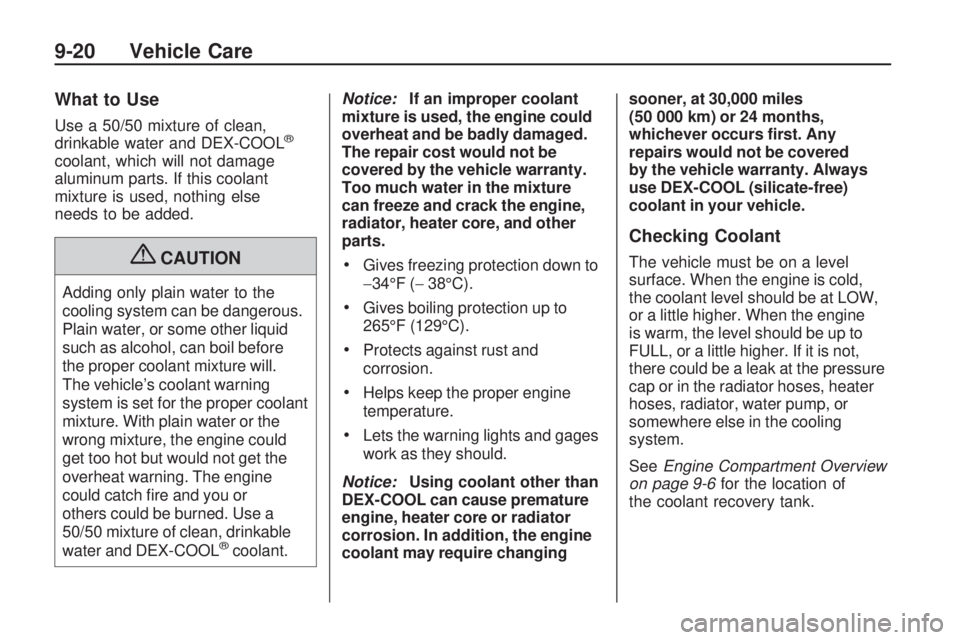
What to Use
Use a 50/50 mixture of clean,
drinkable water and DEX-COOL®
coolant, which will not damage
aluminum parts. If this coolant
mixture is used, nothing else
needs to be added.
{CAUTION
Adding only plain water to the
cooling system can be dangerous.
Plain water, or some other liquid
such as alcohol, can boil before
the proper coolant mixture will.
The vehicle’s coolant warning
system is set for the proper coolant
mixture. With plain water or the
wrong mixture, the engine could
get too hot but would not get the
overheat warning. The engine
could catch fire and you or
others could be burned. Use a
50/50 mixture of clean, drinkable
water and DEX-COOL
®coolant.Notice:
If an improper coolant
mixture is used, the engine could
overheat and be badly damaged.
The repair cost would not be
covered by the vehicle warranty.
Too much water in the mixture
can freeze and crack the engine,
radiator, heater core, and other
parts.
•Gives freezing protection down to
−34°F (− 38°C).
•Gives boiling protection up to
265°F (129°C).
•Protects against rust and
corrosion.
•Helps keep the proper engine
temperature.
•Lets the warning lights and gages
work as they should.
Notice: Using coolant other than
DEX-COOL can cause premature
engine, heater core or radiator
corrosion. In addition, the engine
coolant may require changing sooner, at 30,000 miles
(50 000 km) or 24 months,
whichever occurs �rst. Any
repairs would not be covered
by the vehicle warranty. Always
use DEX-COOL (silicate-free)
coolant in your vehicle.
Checking Coolant
The vehicle must be on a level
surface. When the engine is cold,
the coolant level should be at LOW,
or a little higher. When the engine
is warm, the level should be up to
FULL, or a little higher. If it is not,
there could be a leak at the pressure
cap or in the radiator hoses, heater
hoses, radiator, water pump, or
somewhere else in the cooling
system.
See
Engine Compartment Overview
on page 9-6 for the location of
the coolant recovery tank.
9-20 Vehicle Care
Page 205 of 318
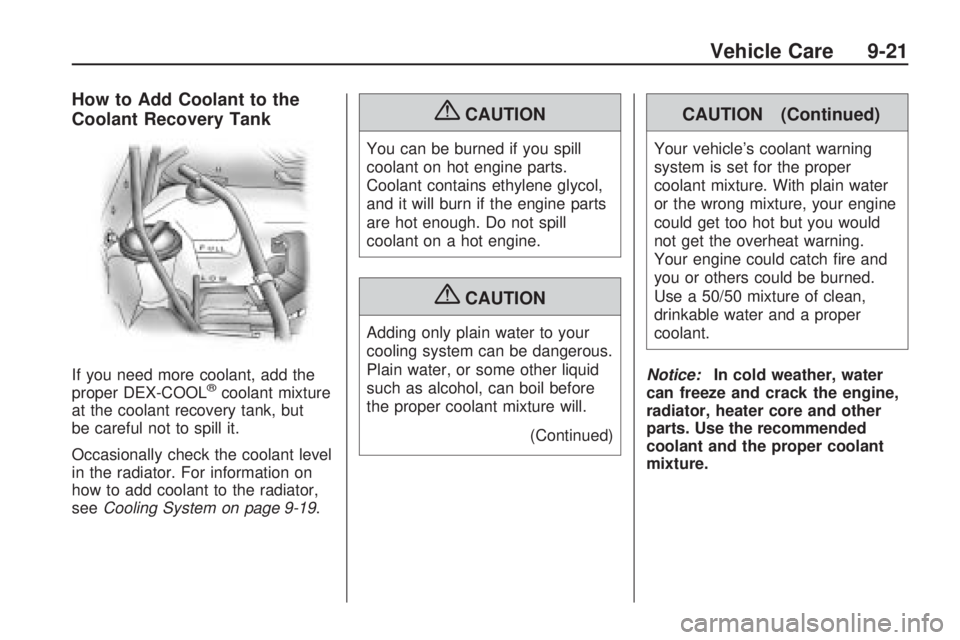
How to Add Coolant to the
Coolant Recovery Tank
If you need more coolant, add the
proper DEX-COOL®coolant mixture
at the coolant recovery tank, but
be careful not to spill it.
Occasionally check the coolant level
in the radiator. For information on
how to add coolant to the radiator,
see Cooling System on page 9-19 .
{CAUTION
You can be burned if you spill
coolant on hot engine parts.
Coolant contains ethylene glycol,
and it will burn if the engine parts
are hot enough. Do not spill
coolant on a hot engine.
{CAUTION
Adding only plain water to your
cooling system can be dangerous.
Plain water, or some other liquid
such as alcohol, can boil before
the proper coolant mixture will.
(Continued)
CAUTION (Continued)
Your vehicle’s coolant warning
system is set for the proper
coolant mixture. With plain water
or the wrong mixture, your engine
could get too hot but you would
not get the overheat warning.
Your engine could catch fire and
you or others could be burned.
Use a 50/50 mixture of clean,
drinkable water and a proper
coolant.
Notice: In cold weather, water
can freeze and crack the engine,
radiator, heater core and other
parts. Use the recommended
coolant and the proper coolant
mixture.
Vehicle Care 9-21
Page 206 of 318
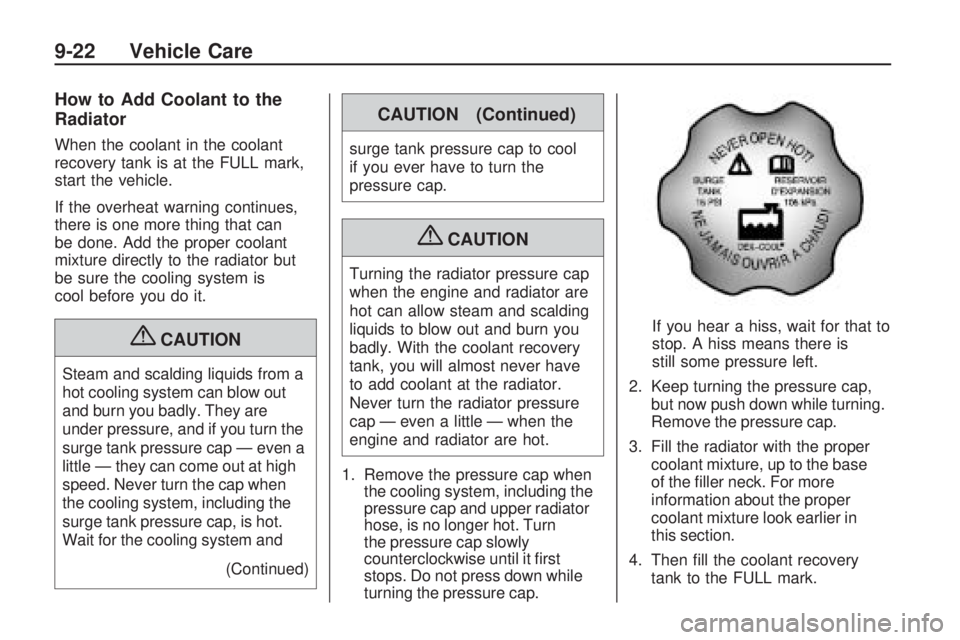
How to Add Coolant to the
Radiator
When the coolant in the coolant
recovery tank is at the FULL mark,
start the vehicle.
If the overheat warning continues,
there is one more thing that can
be done. Add the proper coolant
mixture directly to the radiator but
be sure the cooling system is
cool before you do it.
{CAUTION
Steam and scalding liquids from a
hot cooling system can blow out
and burn you badly. They are
under pressure, and if you turn the
surge tank pressure cap — even a
little — they can come out at high
speed. Never turn the cap when
the cooling system, including the
surge tank pressure cap, is hot.
Wait for the cooling system and(Continued)
CAUTION (Continued)
surge tank pressure cap to cool
if you ever have to turn the
pressure cap.
{CAUTION
Turning the radiator pressure cap
when the engine and radiator are
hot can allow steam and scalding
liquids to blow out and burn you
badly. With the coolant recovery
tank, you will almost never have
to add coolant at the radiator.
Never turn the radiator pressure
cap — even a little — when the
engine and radiator are hot.
1. Remove the pressure cap when the cooling system, including the
pressure cap and upper radiator
hose, is no longer hot. Turn
the pressure cap slowly
counterclockwise until it first
stops. Do not press down while
turning the pressure cap. If you hear a hiss, wait for that to
stop. A hiss means there is
still some pressure left.
2. Keep turning the pressure cap, but now push down while turning.
Remove the pressure cap.
3. Fill the radiator with the proper coolant mixture, up to the base
of the filler neck. For more
information about the proper
coolant mixture look earlier in
this section.
4. Then fill the coolant recovery tank to the FULL mark.
9-22 Vehicle Care
Page 207 of 318
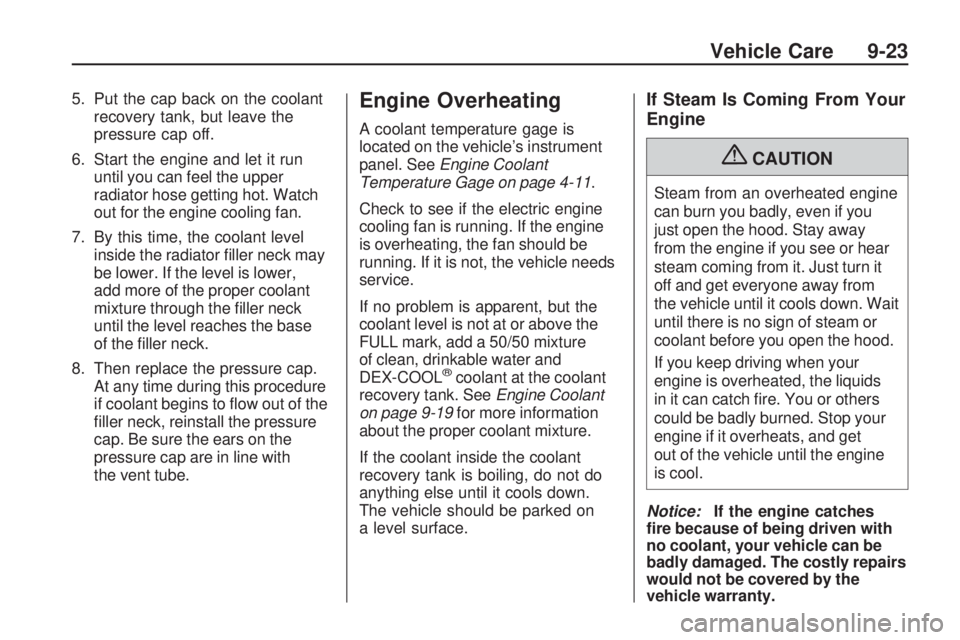
5. Put the cap back on the coolantrecovery tank, but leave the
pressure cap off.
6. Start the engine and let it run until you can feel the upper
radiator hose getting hot. Watch
out for the engine cooling fan.
7. By this time, the coolant level inside the radiator filler neck may
be lower. If the level is lower,
add more of the proper coolant
mixture through the filler neck
until the level reaches the base
of the filler neck.
8. Then replace the pressure cap. At any time during this procedure
if coolant begins to flow out of the
filler neck, reinstall the pressure
cap. Be sure the ears on the
pressure cap are in line with
the vent tube.Engine Overheating
A coolant temperature gage is
located on the vehicle’s instrument
panel. See Engine Coolant
Temperature Gage on page 4-11 .
Check to see if the electric engine
cooling fan is running. If the engine
is overheating, the fan should be
running. If it is not, the vehicle needs
service.
If no problem is apparent, but the
coolant level is not at or above the
FULL mark, add a 50/50 mixture
of clean, drinkable water and
DEX-COOL
®coolant at the coolant
recovery tank. See Engine Coolant
on page 9-19 for more information
about the proper coolant mixture.
If the coolant inside the coolant
recovery tank is boiling, do not do
anything else until it cools down.
The vehicle should be parked on
a level surface.
If Steam Is Coming From Your
Engine
{CAUTION
Steam from an overheated engine
can burn you badly, even if you
just open the hood. Stay away
from the engine if you see or hear
steam coming from it. Just turn it
off and get everyone away from
the vehicle until it cools down. Wait
until there is no sign of steam or
coolant before you open the hood.
If you keep driving when your
engine is overheated, the liquids
in it can catch fire. You or others
could be badly burned. Stop your
engine if it overheats, and get
out of the vehicle until the engine
is cool.
Notice: If the engine catches
�re because of being driven with
no coolant, your vehicle can be
badly damaged. The costly repairs
would not be covered by the
vehicle warranty.
Vehicle Care 9-23
Page 208 of 318
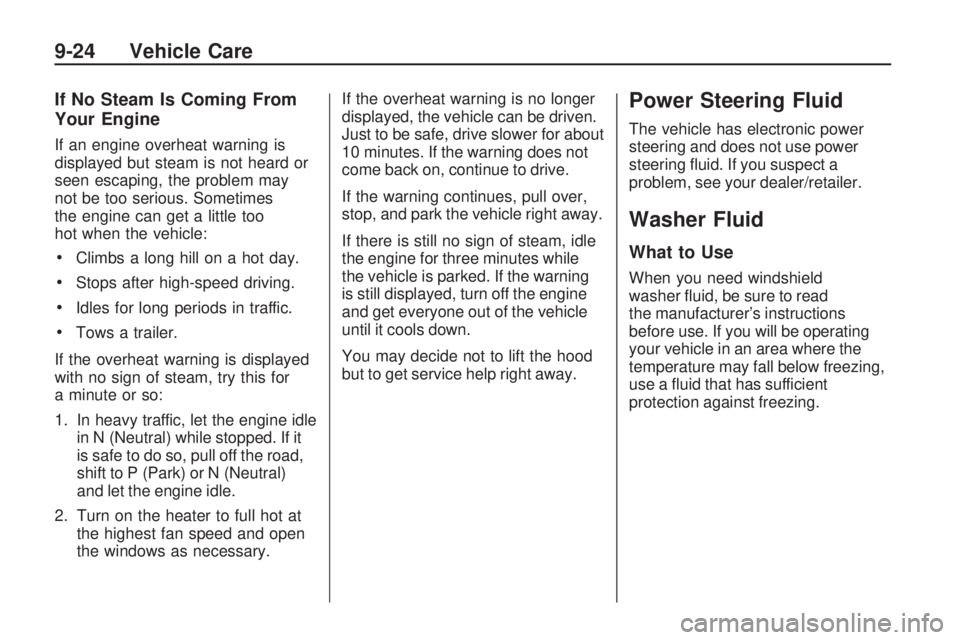
If No Steam Is Coming From
Your Engine
If an engine overheat warning is
displayed but steam is not heard or
seen escaping, the problem may
not be too serious. Sometimes
the engine can get a little too
hot when the vehicle:
•Climbs a long hill on a hot day.
•Stops after high-speed driving.
•Idles for long periods in traffic.
•Tows a trailer.
If the overheat warning is displayed
with no sign of steam, try this for
a minute or so:
1. In heavy traffic, let the engine idle in N (Neutral) while stopped. If it
is safe to do so, pull off the road,
shift to P (Park) or N (Neutral)
and let the engine idle.
2. Turn on the heater to full hot at the highest fan speed and open
the windows as necessary. If the overheat warning is no longer
displayed, the vehicle can be driven.
Just to be safe, drive slower for about
10 minutes. If the warning does not
come back on, continue to drive.
If the warning continues, pull over,
stop, and park the vehicle right away.
If there is still no sign of steam, idle
the engine for three minutes while
the vehicle is parked. If the warning
is still displayed, turn off the engine
and get everyone out of the vehicle
until it cools down.
You may decide not to lift the hood
but to get service help right away.
Power Steering Fluid
The vehicle has electronic power
steering and does not use power
steering fluid. If you suspect a
problem, see your dealer/retailer.
Washer Fluid
What to Use
When you need windshield
washer fluid, be sure to read
the manufacturer’s instructions
before use. If you will be operating
your vehicle in an area where the
temperature may fall below freezing,
use a fluid that has sufficient
protection against freezing.
9-24 Vehicle Care
Page 209 of 318

How to Check Windshield
Washer Fluid
To check windshield washer fluid.
1. Pull dipstick out of windshieldwasher reservoir.
2. Washer fluid should fill the holes between the LOW (B) and
NORMAL (A) mark.
3. If the fluid reads LOW (B) add fluid.
Adding Washer Fluid
Open the cap with the washer
symbol on it. Add washer fluid
until the holes of the dipstick
are filled between the LOW (B)
and NORMAL (A). See Engine
Compartment Overview on
page 9-6 for reservoir location.
Notice:
When using concentrated
washer �uid, follow the
manufacturer’s instructions
for adding water.
Do not mix water with
ready-to-use washer �uid.
Water can cause the solution
to freeze and damage your
washer �uid tank and other
parts of the washer system.
Also, water does not clean
as well as washer �uid.
Fill the washer �uid tank only
three-quarters full when it is
very cold. This allows for �uid
expansion if freezing occurs,
which could damage the tank
if it is completely full.
Do not use engine coolant
(antifreeze) in your windshield
washer. It can damage the
vehicle’s windshield washer
system and paint.
Vehicle Care 9-25
Page 211 of 318
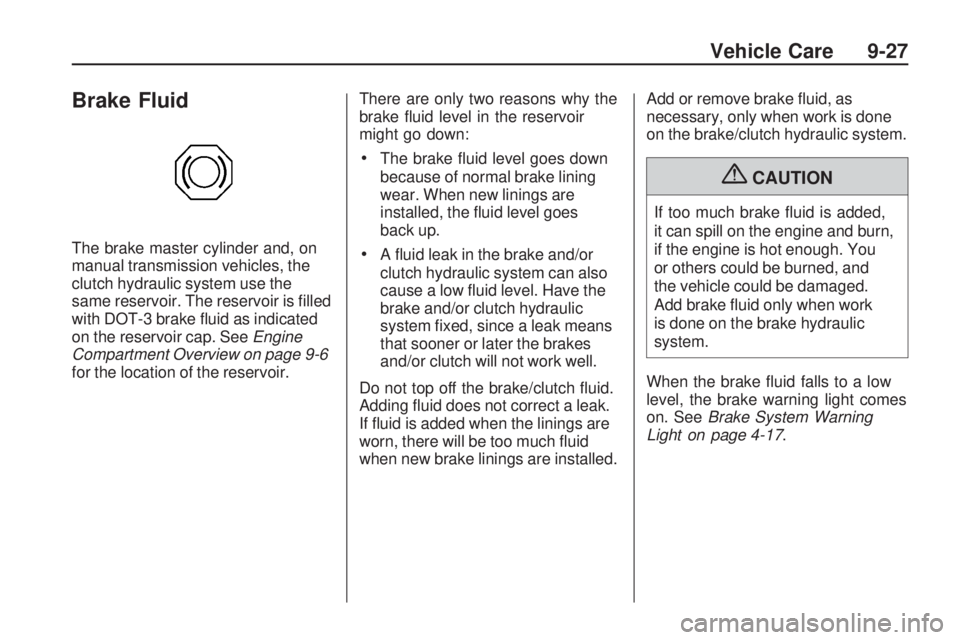
Brake Fluid
The brake master cylinder and, on
manual transmission vehicles, the
clutch hydraulic system use the
same reservoir. The reservoir is filled
with DOT-3 brake fluid as indicated
on the reservoir cap. SeeEngine
Compartment Overview on page 9-6
for the location of the reservoir. There are only two reasons why the
brake fluid level in the reservoir
might go down:
•The brake fluid level goes down
because of normal brake lining
wear. When new linings are
installed, the fluid level goes
back up.
•A fluid leak in the brake and/or
clutch hydraulic system can also
cause a low fluid level. Have the
brake and/or clutch hydraulic
system fixed, since a leak means
that sooner or later the brakes
and/or clutch will not work well.
Do not top off the brake/clutch fluid.
Adding fluid does not correct a leak.
If fluid is added when the linings are
worn, there will be too much fluid
when new brake linings are installed. Add or remove brake fluid, as
necessary, only when work is done
on the brake/clutch hydraulic system.
{CAUTION
If too much brake fluid is added,
it can spill on the engine and burn,
if the engine is hot enough. You
or others could be burned, and
the vehicle could be damaged.
Add brake fluid only when work
is done on the brake hydraulic
system.
When the brake fluid falls to a low
level, the brake warning light comes
on. See Brake System Warning
Light on page 4-17.
Vehicle Care 9-27
Page 212 of 318
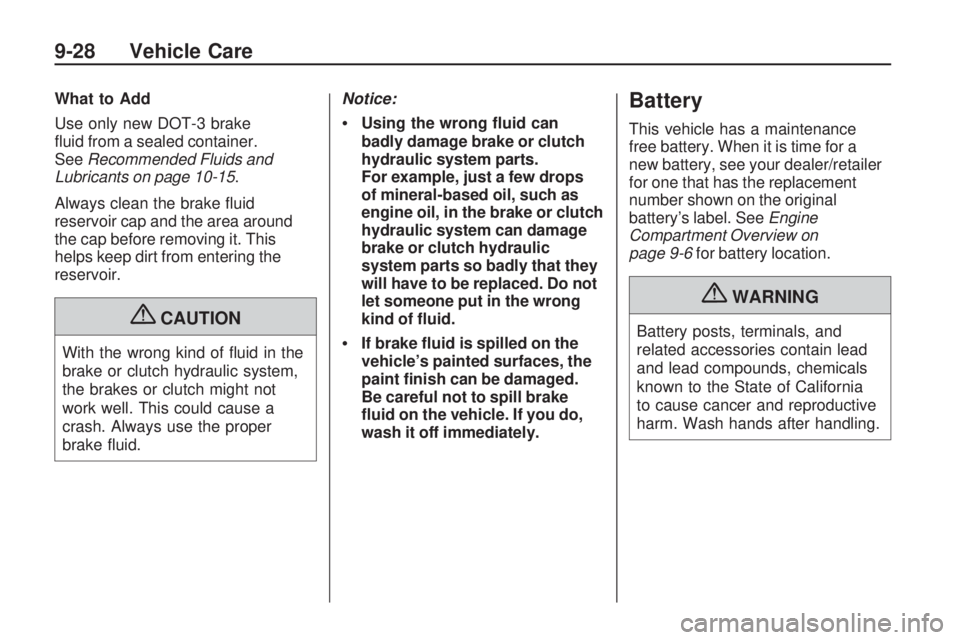
What to Add
Use only new DOT-3 brake
fluid from a sealed container.
SeeRecommended Fluids and
Lubricants on page 10-15 .
Always clean the brake fluid
reservoir cap and the area around
the cap before removing it. This
helps keep dirt from entering the
reservoir.
{CAUTION
With the wrong kind of fluid in the
brake or clutch hydraulic system,
the brakes or clutch might not
work well. This could cause a
crash. Always use the proper
brake fluid. Notice:
Using the wrong �uid can
badly damage brake or clutch
hydraulic system parts.
For example, just a few drops
of mineral-based oil, such as
engine oil, in the brake or clutch
hydraulic system can damage
brake or clutch hydraulic
system parts so badly that they
will have to be replaced. Do not
let someone put in the wrong
kind of �uid.
If brake �uid is spilled on the
vehicle’s painted surfaces, the
paint �nish can be damaged.
Be careful not to spill brake
�uid on the vehicle. If you do,
wash it off immediately.
Battery
This vehicle has a maintenance
free battery. When it is time for a
new battery, see your dealer/retailer
for one that has the replacement
number shown on the original
battery’s label. See
Engine
Compartment Overview on
page 9-6 for battery location.
{WARNING
Battery posts, terminals, and
related accessories contain lead
and lead compounds, chemicals
known to the State of California
to cause cancer and reproductive
harm. Wash hands after handling.
9-28 Vehicle Care
Page 214 of 318
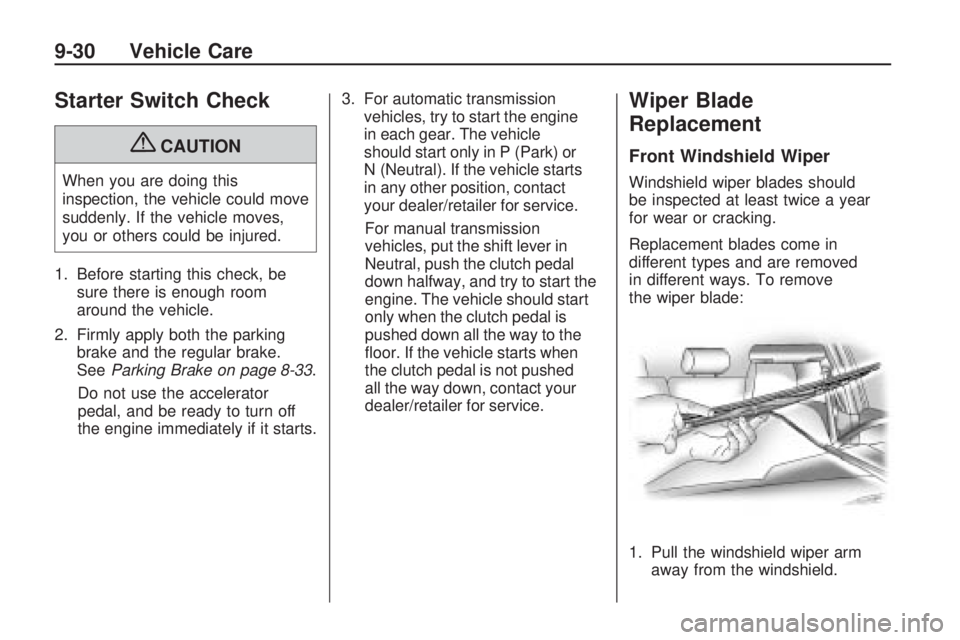
Starter Switch Check
{CAUTION
When you are doing this
inspection, the vehicle could move
suddenly. If the vehicle moves,
you or others could be injured.
1. Before starting this check, be sure there is enough room
around the vehicle.
2. Firmly apply both the parking brake and the regular brake.
See Parking Brake on page 8-33 .
Do not use the accelerator
pedal, and be ready to turn off
the engine immediately if it starts. 3. For automatic transmission
vehicles, try to start the engine
in each gear. The vehicle
should start only in P (Park) or
N (Neutral). If the vehicle starts
in any other position, contact
your dealer/retailer for service.
For manual transmission
vehicles, put the shift lever in
Neutral, push the clutch pedal
down halfway, and try to start the
engine. The vehicle should start
only when the clutch pedal is
pushed down all the way to the
floor. If the vehicle starts when
the clutch pedal is not pushed
all the way down, contact your
dealer/retailer for service.
Wiper Blade
Replacement
Front Windshield Wiper
Windshield wiper blades should
be inspected at least twice a year
for wear or cracking.
Replacement blades come in
different types and are removed
in different ways. To remove
the wiper blade:
1. Pull the windshield wiper arm away from the windshield.
9-30 Vehicle Care
Page 222 of 318
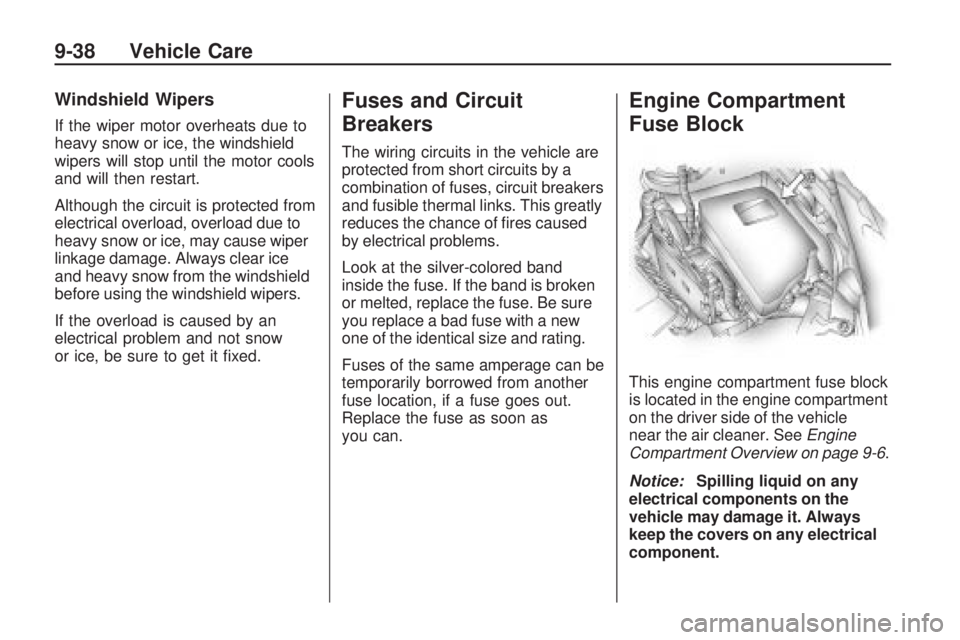
Windshield Wipers
If the wiper motor overheats due to
heavy snow or ice, the windshield
wipers will stop until the motor cools
and will then restart.
Although the circuit is protected from
electrical overload, overload due to
heavy snow or ice, may cause wiper
linkage damage. Always clear ice
and heavy snow from the windshield
before using the windshield wipers.
If the overload is caused by an
electrical problem and not snow
or ice, be sure to get it fixed.
Fuses and Circuit
Breakers
The wiring circuits in the vehicle are
protected from short circuits by a
combination of fuses, circuit breakers
and fusible thermal links. This greatly
reduces the chance of fires caused
by electrical problems.
Look at the silver-colored band
inside the fuse. If the band is broken
or melted, replace the fuse. Be sure
you replace a bad fuse with a new
one of the identical size and rating.
Fuses of the same amperage can be
temporarily borrowed from another
fuse location, if a fuse goes out.
Replace the fuse as soon as
you can.
Engine Compartment
Fuse Block
This engine compartment fuse block
is located in the engine compartment
on the driver side of the vehicle
near the air cleaner. SeeEngine
Compartment Overview on page 9-6 .
Notice: Spilling liquid on any
electrical components on the
vehicle may damage it. Always
keep the covers on any electrical
component.
9-38 Vehicle Care